Prof.Dr. Neepal Imtair Algaraawi
University of Kerbala/Faculty of education for pure science
Sustainability is a concept that involves the idea of sustainable development. In other words, it means the possibility of economic growth and the provision of basic human needs without causing environmental erosion and pollution.
The importance of vegetation in environmental sustainability:
Vegetation is one of the essential elements of the natural environment that plays a vital role in supporting life on planet Earth. Vegetation includes land plants, whether trees or grasses, that cover the Earth’s surface in various forms. Vegetation cover contains a huge diversity of plants, trees, and herbs, ranging between rain-rich tropical regions and dry arid regions. The importance of vegetation cover can be summarized in the following points:
1- Maintaining biological balance:
2- Reducing desertification and ground erosion.
3- Improving air quality:
4- Water purification: reducing pollution of groundwater and natural water sources.
5- Biodiversity: Vegetation is home to many different living organisms.
6- One of the sources of natural economic wealth: Most wild natural plants are a significant source of medicines, health care products, and many food and economic products.
How do we maintain the sustainability of natural vegetation in Iraq (Karbala Governorate as a model)
There are many ways to preserve natural vegetation represented by wild plants, especially in the dry desert environments in Iraq’s western and southwestern regions. For example, the area extends from the west of Lake Al-Razzaza and the west of Ain Al-Tamar district in Karbala to the international border with Saudi Arabia. (Sahib & Algaraawi ,2024).
The wild plants in the governorate can be divided into three groups according to the nature of the soil, the environment, and the type of vegetation prevailing there:
First – The desert environment: It has sandy soils – silica, gypsum, and limestone; its ability to retain water is very weak due to its large pores. Despite this, the area is covered with green cover after rain falls. The Algaraawi & Alsaadi 2021 study collected more than 200 wild plant species, including Haloxylon salicornicum and Tamarix. There is also a heavy spread of Aaronsohnia and Baboong Anthemis Desertii and Aizonanthemum Hispanicum, especially after the rainy season. It has also been observed that the spread of parasitic plants, such as hallow plant Cistanche violacea and Haloxylon Salicornisum, Rumex Vesicarius Haloxylon Persicum (Algaraawi & Hamid ,2023: Taher & Algaraawi, 2022, Sahib & Algaraawi, 2024).
Second: Valley environment
It is distinguished by its alluvial mixture soil consisting of sand, clay, and silt. The valley retains moisture after the rainy season, making it moist soil in which there are many species of perennial wild plants, such as the wild Sidr communities Ziziphus Nummularia, Ramth, and Hammas-Zygophyllum Coccineum, as dominant communities, and annual plants spread in it immediately after the rainy season, such as Chrozophora Tinctoria, Andrachne Telephioides, and Harisha. Brassica Tournefortii, Artemisia Campestris, Cardus Getulus, Harmal, Peganum Harmala, Anabasis Setifera, Atriplex sp., Salvia Spinosa, Malva Parviflora, mustard, and Capparis Spinosa (Taher and Algaraawi ,2022).
Third – The environment of orchards and farmed lands:
The orchards of the districts and areas adjacent to the governorate center are characterized by two types of soil: the soil of the river shoulders. Its waters and these communities are represented by reeds, basil, half, and aqua, which are communities that grow in humid environments or near the streams, canals, and streams that feed these orchards—likewise, the existence of the Dichanthium Annulatum, Ammi Majus (Algaraawi & Hamid ,2023: Taher &algaraawi ,2022).
This region is characterized by the availability of a sea of groundwater that extends over large areas between Iraq and Saudi Arabia. This water has been exploited by drilling wells and planting large areas with field crops that are tolerant to the salinity of that water. There are also significant projects to grow these areas with oases of palm trees and economic fruit trees, and this has been rationalized. Consumption of well water for irrigation through the use of economical irrigation methods such as sprinklers and drip irrigation to suit the nature of the sandy soil that does not retain water for long periods.
The most prominent plans and strategies that must be followed to achieve a sustainable environment and address the decline of natural vegetation.
A joint, thoughtful plan should be clarified in coordination with all relevant authorities in the governorate and relevant ministries in the state, which includes initiating an increase in agricultural projects for palm oases and field crops in the desert areas or the Western Plateau, provided that the oases and cultivated lands are distributed over long distances between them to enclose between them large unexploited areas arranged in alternating order in a checkerboard pattern to form an environment suitable for the growth of natural wild plants. In other words, large areas are allocated as natural reserves surrounded by lands farmed with economic trees, especially palm trees, and salt-tolerant field crops. Since farmed lands surround these unexploited areas or reserves, this contributes to the flourishing growth of natural wild plants throughout the months of the year, and their growth is not limited to after the rainy season. This is due to several reasons, the most important of which is:
1- Dividing lands in the desert or the Western Plateau in a checkerboard manner, represented by the exchange of farmed lands and oases with adjacent unfarmed areas (natural reserves), will contribute to surrounding a large number of these natural reserves with farmed lands and avoid sweeping away the sandy soil and thus sweep away the plants.
2- The availability of a water source in the farmed lands and oases surrounding the reserves will cause the edges of those reserves adjacent to the borders of the cultivated lands to be moistened, thus indirectly providing a source of water for wild plants. This leads to prolonging the growing seasons of wild plants throughout the year, at least at the edges of those lands after they were. It is limited to rainy seasons only. The availability of moisture also increases plant diversity and spread, as well as the dominance of certain species over others, depending on the nature of the soil.
3- After several seasons of indirect water availability in the reserves as a result of their surrounding the wet soils of the confiscated lands and neighboring oases and providing buffers for erosion factors, this will be an incentive for the flourishing of many perennial wild plants, such as wild cedar, tamarisk trees to form essential forests. as this forms a shade for smaller wild plants that are not tolerant of heat and sunlight, meaning an increase in plant biodiversity and thus animals (Sahib &Algaraawi,2024).
4- The flourishing growth of annual wild plants contributes to increasing the organic materials of the soil through the decomposition of those plants after the end of their growing season, as the soil is characterized by its lack of these materials. This will change the texture of the sandy soil, increase its cohesion, reduce the interspaces between its particles, and provide it with important elements and nutrients for wild plants, and thus Retaining or capturing the largest amount of water and humidity.
Papaver glaucum Brassica nigra
Teucrium oliverianum ( Alhandhal ) Citrullus colocynthis
A
B
(A –B )communities of (Al-Ramth) Haloxylon salicornisum , (Al-Aqul) Alhagi , (Al-Hammat) Moltkiopsis ciliata, – (Hamas) Zygophyllum coccineum (Al-Jabajb) Cornulaca monacantha.
(Sider berri )Ziziphus nummularia
(baboong) Anthemis desertii
Cistanche violacea, Rhanterium epapposum L
Anthemis desertii Rumex vesicarius
Reseda muricata Tamarix smyrnensis
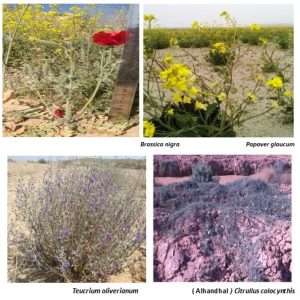
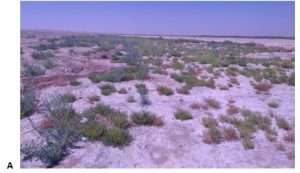
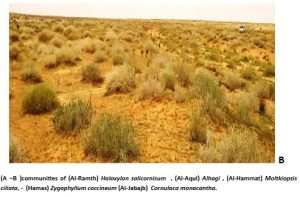
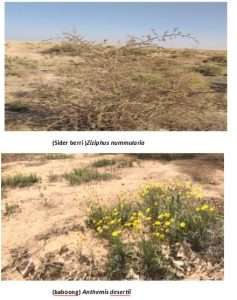

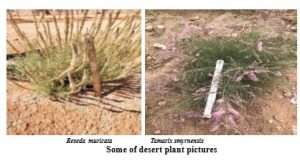
Some of desert plant pictures
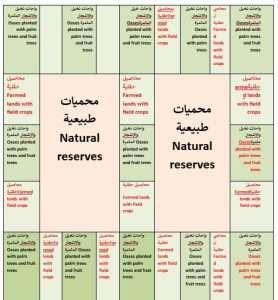
A diagram showing how to create natural reserves surrounded by oases and farmed lands.
References
– Taher H.S., Algaraawi,N.I. and AlArdawi,K.G. Survey study to four families of Dicotyledon in Ain Al-tamur district.. Samarra J. Pure Appl. Sci., 2022; 4 (4): 109-122.
– Al-Garaawi,N.I. Hamid,B.A.. A Survey Study of Wild Plants in AL Al Najaf Desert .International Journal of Aquatic Science. Vol 14, Issue 01, 2023.
– Sahib, H. A., & AlGaraawi, N. I. (2024). A survey study of the plants of Al Hur District in the Holy City of Karbala. International Journal of Health Sciences, 8(S1), 612–637. Retrieved fromhttps://sciencescholar.us/journal/index.php/ijhs/article/view/14871.





























































